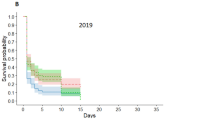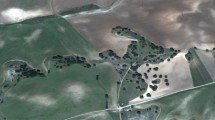Abstract
Plants can reduce the fitness costs of granivory by satiating seed predators. The most common satiation mechanism is the production of large crops, which ensures that a proportion of the seeds survive predation. Nevertheless, satiation of small granivores at the seed level may also exist. Larger seeds would satiate more efficiently, enhancing the probability of seed survival after having been attacked. However, a larger seed size could compromise the efficiency of satiation by means of large crops if there were a negative relationship between seed size and the number of seeds produced by an individual plant. We analyze both types of satiation in the interaction between the holm oak Quercus ilex and the chestnut weevil Curculio elephas. Both crop size and acorn size differed strongly in a sample of 32 trees. Larger crop sizes satiated weevils, and higher proportions of the seeds were not attacked as crop size increased. Larger seeds also satiated weevil larvae, as a larger acorn size increased the likelihood of embryo survival. Seedling size was strongly related to acorn size and was reduced by weevil attack, but seedlings coming from large weeviled acorns were still larger. The number and the size of the acorns produced by individual trees were negatively related. Larger proportions of the crop were infested in oaks producing less numerous crops of larger acorns. However, contrary to expectations, these trees did not satiate more effectively at the seed level either. Effective satiation by larger acorns was precluded by larger multi-infestation rates associated to smaller seed crops, in such a way that the proportion of attacked seeds that survived did not vary among trees with different acorn sizes. These results highlight the need of considering satiation by means of large crops and large seeds in studies of predispersal seed predation. Long-term monitoring on individual oaks will help to assess whether there is a trade-off between the number and the size of the acorns and, if it existed, how it could condition the fitness consequences of both types of satiation.



Similar content being viewed by others
References
Blanco E, Casado MA, Costa M, Escribano R, García M Génova M, Gómez A, Gómez F, Moreno JC, Morla C, Regato P, Sáinz H (1997) Los Bosques Ibéricos. Una Interpretación Geobotánica. Planeta, Madrid, Spain
Bonal R (2005) Fitness consequences of the interactions between Quercus ilex and its specialist predispersal seed predator, Curculio elephas. PhD Thesis. Universidad Autónoma de Madrid. Madrid
Branco M, Branco C, Merouani H, Almeida MH (2002) Germination success, survival and seedling vigour of Quercus suber acorns in relation to insect damage. For Ecol Manage 166:159–164
Cipollini ML, Stiles EW (1991) Seed predation by the bean weevil Acanthoscelides obtectus on Phaseolus species: consequences for seed size, early growth and reproduction. Oikos 60:205–214
Coutin R (1960) Estimation de l´importance des populations d´imagos de Balaninus elephas Gyll dans une châtaigneraie cévenole. Rev Zool Agr Appl 59:1–5
Crawley MJ (1997) Plant-herbivore dynamics. In: Crawley MJ (ed) Plant ecology. Blackwell, Oxford, pp 401–474
Crawley MJ, Long CR (1995) Alternate bearing, predator satiation and seedling recruitment in Quercus robur. J Ecol 83:683–696
Dalling JW, Harms KE (1999) Damage tolerance and cotyledonary resource use in the tropical tree Gustavia superba. Oikos 85:257–264
Dalling JW, Harms KE, Aizprua R (1997) Seed damage tolerance and seedling resprouting ability of Prioria copaifera in Panama. J Trop Ecol 13:481–490
Desouhant E (1998) Selection of fruits for oviposition by the chestnut weevil, Curculio elephas. Entom Exp Appl 86:71–78
Desouhant E, Debouzie D, Ploye H, Menu F (2000) Clutch size manipulations in the chestnut weevil, Curculio elephas: fitness of oviposition strategies. Oecologia 122:493–499
Debouzie D, Heizmann A, Desouhant E, Menu F (1996) Interference at several temporal and spatial scales between two chestnuts insects. Oecologia 108:151–158
Díaz M (1996) Food choices by seed-eating birds in relation to seed chemistry. Comp Biochem Physiol 113A:239–246
Díaz M, Martín P (1998) Habitat selectivity by wintering woodpigeons (Columba palumbus) in Holm-oak Quercus ilex dehesas of central Spain. Gibier Faune Sauv/Game Wildl 15:167–181
Díaz M, González E, Muñoz-Pulido R, Naveso MA (1993) Effects of food abundance and habitat structure on seed-eating rodents wintering in Spanish man-made habitats. Z Säugetierk 58:302–311
Díaz M, González E, Muñoz-Pulido R, Naveso MA (1995) Habitat selection patterns of common cranes Grus grus wintering in Holm-oak Quercus ilex dehesas of central Spain: effects of human management. Biol Conserv 75:119–124
Díaz M, Campos P, Pulido FJ (1997) The Spanish dehesa: a diversity in land use and wildlife. In: Pain DJ, Pienkowski MW (eds) Farming and birds in Europe. The common agricultural policy and its implications for bird conservation. Academic Press, London, pp 178–209
Díaz M, Møller AP, Pulido FJ (2003) Fruit abortion, developmental selection and developmental stability in Quercus ilex. Oecologia 135:378–385
Eikenbary RD, Raney HG (1973) Intratree dispersal of the pecan weevil. Environ Entomol 2:927–930
Eriksson O, Jakobsson A (1999) Recruitment trade-offs and the evolution of dispersal mechanisms in plants. Evol Ecol 13:411–423
Fernández-Carrillo JL (1995) Las especies del género Curculio (Coleoptera Curculionidae) del Parque Nacional de Cabañeros. MaD Thesis, University of Castilla-La Mancha, Toledo
Gómez JM (2004a) Importance of microhabitat and acorn burial on Quercus ilex early recruitment: non-additive effects on multiple demographic processes. Plant Ecol 172:287–297
Gómez JM (2004b) Bigger is not always better: conflicting selective pressures on seed size in Quercus ilex. Evolution 58:71–80
Harper JL, Lowell PH, Moore KG (1970) The shapes and sizes of seeds. Ann Rev Ecol and Syst 1:327–356
Herrera CM, Jordano P, Guitián J, Traveset A (1998) Annual variability in seed production by woody plants and the masting concept: reassessment of principles and relationship to pollination and seed dispersal. Am Nat 152:576–594
Hughes J, Vogler AP (2004) Ecomorphological adaptation of acorn weevils to their oviposition site. Evolution 58:1971–1983
Hulme PE, Benkman CW (2002) Granivory. In: Herrera CM, Pellmyr O (eds) Plant–animal interactions, an evolutionary approach. Blackwell, Oxford, pp 77–106
Janzen DH (1969) Seed eaters versus seed size, number, toxicity and dispersal. Evolution 23:1–27
Janzen DH (1971) Seed predation by animals. Ann Rev Ecol Syst 2:465–492
Jiménez J (1998) Guía de visita del Parque Nacional de Cabañeros. Ministerio de Medio Ambiente, Madrid
Kelly D (1994) The evolutionary ecology of mast seeding. Trends Ecol Evol 9:465–470
Kelly D, Sork VL (2002) Mast seeding in perennial plants: why, how, where? Ann Rev Ecol and Syst 33:427–447
Kelrick MI, MacMahon JA, Parmenter RR, Sisson DV (1986) Native seed preferences of shrub-steppe rodents, birds and ants: the relationships of seed attributes and seed use. Oecologia 68:327–337
Leiva MJ, Fernández-Alés R (1998) Variability in seedling and water status during drought within a Quercus ilex subsp. ballota population, and its relation to seedling morphology. For Ecol Manage 111:147–156
Leiva MJ and Fernández-Alés R (2003) Post-dsipersive losses of acorns from Mediterranean savannah-like forests and shrublands. For. Ecol Manage 176:265–271
Leiva MJ and Fernández-Alés R (2005) Holm-oak (Quercus ilex Subs. Ballota) acorns infestation by insects in Mediterranean dehesas and shrublands. Its effect on acorn germination and seedling emergence. For. Ecol. Manage 221:221–229
Mack AL (1998) An advantage of large seed size: tolerating rather than succumbing to seed predators. Biotropica 30:604–608
Menu F (1993) Strategies of emergence in the chestnut weevil Curculio elephas (Coleoptera: Curculionidae). Oecologia 96:383–390
Menu F, Debouzie D (1993) Coin-flipping plasticity and prolonged diapause in insects: example of the chestnut weevil Curculio elephas (Coleoptera: Curculionidae). Oecologia 93:367–373
Miller DR, Schlarbaum SE (2005) Acorn fall and weeviling in a norther red oak seedling orchard. J Entomol Sci 40:31–38
Moles AT, Westoby M (2004) Seedling survival and seed size: a synthesis of the literature. J Ecol 92:372–383
Muñoz A (2005) Ecological analyses of seed predation and dispersal by Algerian mice (Mus spretus) and wood mice (Apodemus sylvaticus) foraging on Holm oak (Quercus ilex) acorns. PhD Thesis, Universidad Complutense, Madrid
Oliver AD, Chapin JB (1984) Curculio fulvus (Coleoptera, Curculionidae) and its effects on acorns of live oaks, Quercus virginiana Miller. Environ Entomol 13:1507–1510
Parciak W (2002) Seed size, number, and habitat of a fleshy-fruited plant: consequences for seedling establishment. Ecology 83:794–808
Pulido FJ, Díaz M (2002) Dinámica de la regeneración natural del arbolado de encina y alcornoque. In: Pulido FJ, Campos P, Montero G (eds) La gestión forestal de las dehesas. IPROCOR, Mérida, Spain, pp 39–62
Pulido FJ, Díaz M (2005) Regeneration of a Mediterranean oak: a whole-cycle approach. EcoScience 12:92–102
Pulido FJ, Díaz M, Hidalgo SJ (2001) Size-structure and regeneration of holm oak (Quercus ilex) forests and dehesas: effects of agroforestry use on their long term sustainability. For Ecol Manage 146:1–13
Rupérez A (1957) La encina y sus tratamientos. Ediciones Selvícolas, Madrid, Spain
Sakai S, Harada Y (2001) Sink-limitation and the size-number trade-off of organs: Production of organs using a fixed amount of reserves. Evolution 55:467–476
Siscart D, Diego V, Lloret F (1999) Acorn ecology. In: Rodà F, Gracia C, Retana J, Bellot J (eds) The ecology of Mediterranean evergreen forests. Springer, Heidelberg, Germany, pp 75–87
Skalski JR (1987) Selecting a random sample of points in circular field plots. Ecology 68:749
Smith CC, Fretwell SD (1974) The optimal balance between size and number of offspring. Am Nat 108:499–506
Soria FJ, Cano E, Ocete ME. (1996) Efectos del ataque de fitófagos perforadores en el fruto de la encina (Quercus rotundifolia Lam.). Bol de Sanidad Vegetal Plagas 22:427–432
Sousa WP, Kennedy PG, Mitchell BJ. (2003) Propagule size and predispersal damage by insects affect establishment and early growth of mangrove seedlings. Oecologia 135:567–575
Stowe KA, Marquis RJ, Hochwender CG, Simms EL (2000) The evolutionary ecology of tolerance to consumer damage. Ann Rev Ecol Syst 31:565–595
Vázquez FM (1998) Semillas de Quercus. Biología, ecología y manejo. Consejería de Agricultura y Comercio, Badajoz
Westoby M, Jurado E, Leishman M (1992) Comparative evolutionary ecology of seed size. Trends Ecol Evol 7:368–372
Acknowledgments
Comments of F.J. Pulido, J.M. Gómez and two anonymous referees improved previous versions of this manuscript. L. Arroyo, B. Nicolau, A. Nicolau and N. Fermín helped with the field work. J. L. Fernández-Carrillo confirmed the identification of the weevil species. L. Muñoz helped us with the mathematical model. J. Jiménez allowed and provided facilities for field work at Cabañeros National Park. M. Díaz gave permission to perform the common garden experiment. This study was supported by the projects REN2003-07048/GLO of the Spanish Ministerio de Ciencia y Tecnología, PAC-02-008 of the Junta de Comunidades de Castilla-La Mancha and 096/2002 of the Spanish Ministerio de Medio Ambiente. RB and AM were supported by fellowships from the Junta de Comunidades de Castilla-La Mancha.
Author information
Authors and Affiliations
Corresponding author
Rights and permissions
About this article
Cite this article
Bonal, R., Muñoz, A. & Díaz, M. Satiation of predispersal seed predators: the importance of considering both plant and seed levels. Evol Ecol 21, 367–380 (2007). https://doi.org/10.1007/s10682-006-9107-y
Received:
Accepted:
Published:
Issue Date:
DOI: https://doi.org/10.1007/s10682-006-9107-y




